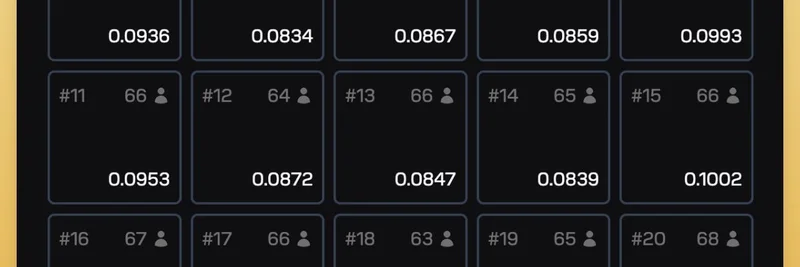Hey there, crypto enthusiasts! If you've been following the Solana ecosystem, you might remember ORE as that ambitious project aiming to create a native store of value asset. Well, buckle up because ORE is back with a bang. In a recent thread on X, the team announced a complete overhaul of their mining protocol. This isn't just a tweak—it's a redesign focused on accruing revenue, ensuring sustainable tokenomics, and rewarding long-term holders. Let's dive into what this means for the project and why it could be a game-changer in the world of meme tokens and beyond.
Background on ORE's Journey
ORE first launched about 1.5 years ago with the goal of building a Bitcoin-inspired proof-of-work (PoW) system on Solana. Proof-of-work, for those new to crypto, is a consensus mechanism where miners solve complex puzzles to validate transactions and earn rewards—think Bitcoin's energy-intensive mining. ORE's initial setup generated massive buzz, but it also overwhelmed Solana's network with a surge of transactions, essentially "breaking" the chain temporarily. Despite the hype, it set the stage for ORE as a serious contender in Solana's DeFi and meme token scene.
Identifying the Core Problems
Over time, the team and community spotted some major flaws in the traditional PoW model. The biggest issue? Value leakage. Parasitic users—those who mine and dump tokens without contributing to the ecosystem—were draining value from genuine holders. This misalignment of incentives hindered ORE's mission to become a reliable store of value, like a digital gold on Solana. Store of value assets are those that hold or increase in worth over time, resistant to inflation and market volatility.
The Big Pivot: A New Approach
Faced with these challenges, the ORE community didn't just patch things up—they reimagined the entire system. After months of testing, they landed on a novel mechanism that flips the script: instead of leaking value, it captures it and redistributes to committed participants. This pivot prioritizes sustainability and aligns incentives with long-term believers, making ORE more appealing for serious blockchain practitioners.
How the New Mining Works
At the heart of the relaunch is a fresh mining protocol that's both innovative and accessible. Imagine a 5x5 grid of blocks— that's 25 spots in total. Every round lasts one minute, during which miners stake SOL (Solana's native token) to claim space on these blocks.
Once the timer hits zero, a secure random number generator (powered by Solana's tech) picks one winning block. Here's where it gets exciting: All the SOL staked on the losing 24 blocks gets split among the winners based on their stake proportion. Plus, one miner on the winning block gets a +1 ORE reward via weighted chance. About every third round, that ORE reward is shared among all winners instead.
This setup turns mining into a strategic game, where positioning your SOL stake could yield big returns without the energy waste of traditional PoW.
Introducing the Motherlode Feature
To add some thrill, there's the "motherlode"—a accumulating pool that grows by +0.2 ORE each round. When a winning block is selected, there's a slim 1 in 625 chance (that's 0.16%) of hitting the motherlode. If you do, the entire pool is divvied up among the winners proportional to their stakes. If not, it rolls over, building up for future rounds. It's like a crypto lottery baked into the protocol, encouraging consistent participation.
Refining Fees: Rewarding Patience
ORE introduces a 10% "refining fee" on all claimed mining rewards. But don't worry—this isn't just a tax. The fees are redistributed to other miners based on their unclaimed ORE. In simple terms, the longer you hold off on claiming your rewards, the more you benefit from others' fees. This mechanic incentivizes long-term holding, filtering out short-term flippers and bolstering the token's stability.
Generating Protocol Revenue
One of the smartest moves in this redesign is how ORE captures revenue. A flat 10% of all SOL mining rewards goes straight to the protocol. This pot is then used for automated buybacks of ORE from the open market. Over the past week alone, this has funneled over 990 SOL into buybacks.
Bought-back tokens are "buried"—a community-coined term for burning them, but with a twist: They can be mined again as long as the circulating supply stays under the max cap. In the last seven days, over 6,290 ORE have been buried this way.
The Bury Mechanism Explained
Burying isn't your standard burn. It reduces circulating supply temporarily, creating deflationary pressure that can boost token value. Since buried ORE can re-enter circulation through mining, it keeps the ecosystem dynamic without permanent loss. This balances inflation control with ongoing rewards.
Staking for Long-Term Holders
Staking gets a revenue-backed upgrade too. Of the ORE bought back with protocol funds, 90% is buried, and 10% is distributed as yield to stakers. Unlike inflationary staking in many projects, this is funded purely by real revenue—no dilution for holders. It's a win for those committed to ORE's vision.
Tokenomics: Balancing Inflation and Deflation
ORE sticks to its roots with a max supply of 5 million tokens and an average emission rate of about 1 ORE per minute. But thanks to revenue-driven buybacks and burying, net emissions can swing from mild inflation to outright deflation if revenues spike. This flexible model adapts to market conditions, making ORE more resilient.
For deeper dives into transaction history and mechanics, check out the ORE website.
Wrapping Up: A New Era for ORE
This relaunch isn't just technical—it's a philosophical shift toward value capture and community alignment. By ditching the flaws of traditional PoW and introducing features like the motherlode and refining, ORE is positioning itself as a frontrunner in Solana's store of value niche. Whether you're a miner, staker, or just watching from the sidelines, this could spark fresh interest in meme tokens with real utility. Keep an eye on ORE; it might just mine its way to the top. What do you think—ready to stake some SOL?



